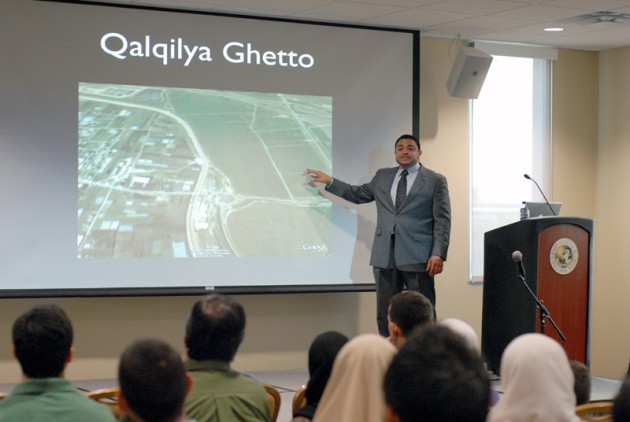Palestinian-Israeli conflict brought to students’ attention

Local human rights advocates are hoping to raise awareness about the Palestinian-Israeli conflict issues and debunk common myths about the problems the areas are facing.
To advance these goals, the Muslim Student Association sponsored a panel discussion Wednesday night titled “21st Century Apartheid: Demystifying the Palestinian-Israeli Conflict” and featured guest speakers Ahmed Bedir, a Tampa Bay radio host, and Mauri’ Saalakhan, an author.
For decades, Israelis and Palestinians have fought over whether the state of Israel and land in the West Bank and Gaza Strip should form one united state or be separated into two states, but the issue at hand, the guest speakers said, is how Palestinians have been treated over the years. Their human rights have essentially been denied, they said.
Both speakers said they want to make students aware of the violence and mistreatment surrounding the battling factions.
Bedir said he wanted the event to raise awareness in an inspirational way.
“College students need perspective on these global concerns and have the ability to voice their opinions on such a matter,” he said.
Bedir showed a multimedia presentation outlining the historical context behind the conflict of the area. Violence has been occurring because of false promises and harsh Israeli occupancy of the Gaza Strip and West Bank territories, he said.
Three different peace treaties have been proposed between Israeli and Palestinian leaders at certain points in time, each one granting the Palestinians less land along the West Bank. The first treaty, proposed in 1968, would have granted Palestine 55 percent of the land, and Israel would receive other 45 percent. In 1993, that figure dropped to 22 percent to Palestine, and in 2000, the figure was changed to 18 percent, with Israel getting the remaining 82 percent, the lecturers said.
Bedir said these peace treaties haven’t done much good and have conjured up mixed feelings from both parties.
He said the different conflicts that have arisen and occurred on both sides and Palestinians go through hardships on daily that stifle their lifestyles. These include strict checkpoints, harsh separation laws and barricades upheld by Israeli militant troops.
Saalakhan’s discussion compared the Palestinian-Israeli conflict to the apartheid that occurred in South Africa in the ’80s. This similarity, he said, is because of strict laws imposed on Palestinians and the oppression shown toward them by Israel, who occupies the land.
Saalakhan quoted other influential human rights advocates in support of his views and said he wanted to bring attention to the “terrible mistreatment” that has been happening to Palestinians. He also read passages from his book, The Palestinian’s Holocaust: American Perspectives.
Bedir encouraged members of the audience to participate in civic engagement and help inform others to become more aware of these issues, as well as help put a stop to the violence.
Saalakhan said he wanted students in the audience to talk to others about the conflict, letting the panel discussion’s remarks carry on to a wider audience by word of mouth.
This is a big issue which people don’t get to see both sides,” said senior biomedical science major Sarah Soltau. “Students should be conscious of the problems, and this discussion is targeted to take away the biases already associated with this conflict.”
Awab Nasr, a senior business major, said Saalakhan’s discussion was profound.
“It’s great to have an event of this caliber here on campus to bring up such pressing issues concerning Palestine and Israel,” Nasr said.
Students can learn more about the Palestinian-Israeli conflict during screening of the documentary Occupation 101 at 6 p.m. in the University Lecture Hall.






